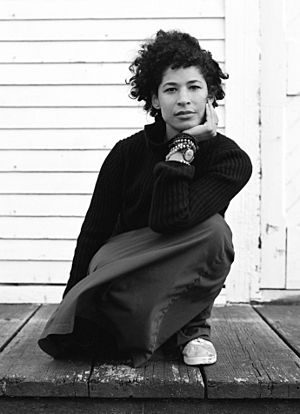Third-wave feminism facts for kids

Third-wave feminism is an iteration of the feminist movement. It began in the United States in the early 1990s and continued until the rise of the fourth wave in the 2010s. Born in the 1960s and 1970s as members of Generation X and grounded in the civil-rights advances of the second wave, third-wave feminists embraced diversity and individualism in women and sought to redefine what it meant to be a feminist. The third wave saw the emergence of new feminist currents and theories, such as intersectionality, vegetarian ecofeminism, transfeminism, and postmodern feminism.
The term third wave was coined by Rebecca Walker. Walker sought to establish that third-wave feminism was not just a reaction, but a movement in itself, because the feminist cause had more work ahead. The term intersectionality—to describe the idea that women experience "layers of oppression" caused, for example, by gender, race and class—had been introduced by Kimberlé Crenshaw in 1989, and it was during the third wave that the concept flourished. As feminists came online in the late 1990s and early 2000s and reached a global audience with blogs and e-zines, they broadened their goals, focusing on abolishing gender-role stereotypes and expanding feminism to include women with diverse racial and cultural identities.
Contents
History
The rights and programs gained by feminists of the second wave served as a foundation for the third wave. The gains included Title IX (equal access to education), child-care services, educational funding for young women, and women's studies programs.
Feminist leaders rooted in the second wave such as Gloria E. Anzaldúa, bell hooks, Cherríe Moraga, Audre Lorde, Maxine Hong Kingston, and other feminists of color, sought to negotiate a space within feminist thought for consideration of race. Cherríe Moraga and Gloria E. Anzaldúa had published the anthology This Bridge Called My Back (1981), which, along with All the Women Are White, All the Blacks Are Men, But Some of Us Are Brave (1982), edited by Akasha (Gloria T.) Hull, Patricia Bell-Scott, and Barbara Smith, argued that second-wave feminism had focused primarily on the problems of white women. The emphasis on the intersection between race and gender became increasingly prominent.
Another crucial point for the start of the third wave is the publication in 1990 of Gender Trouble: Feminism and the Subversion of Identity by Judith Butler, which soon became one of the most influential works of contemporary feminist theory.
Early years
The emergence of riot grrrl, the feminist punk subculture, in the early 1990s in Olympia, Washington, marked the beginning of third-wave feminism. The triple "r" in grrrl was intended to reclaim the word girl for women.
Riot grrrl was grounded in the DIY philosophy of punk values, adopting an anti-corporate stance of self-sufficiency and self-reliance. Its emphasis on universal female identity and separatism often appeared more closely allied with second-wave feminism.
Purpose
Arguably the biggest challenge to third-wave feminism was that the gains of second-wave feminism were taken for granted, and the importance of feminism not understood.
Essentially the claim was that gender equality had already been achieved, via the first two waves, and further attempts to push for women's rights were irrelevant and unnecessary, or perhaps even pushed the pendulum too far in women's favor. This issue manifested itself in the heated debates about whether affirmative action was creating gender equality or punishing white, middle-class males for the biological history that they had inherited. Third-wave feminism therefore focused on Consciousness raising— one's ability to open their mind to the fact that male domination does affect the women of our generation, is what we need.
Third-wave feminists often engaged in "micro-politics", and challenged the second wave's paradigm as to what was good for women. Proponents of third-wave feminism said that it allowed women to define feminism for themselves.
Issues
Third-wave feminism regarded race, social class, and transgender rights as central issues. It also paid attention to workplace matters such as the glass ceiling, unfair maternity-leave policies, motherhood support for single mothers by means of welfare and child care, respect for working mothers, and the rights of mothers who decide to leave their careers to raise their children full-time.
See also
 In Spanish: Tercera ola del feminismo para niños
In Spanish: Tercera ola del feminismo para niños

